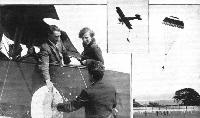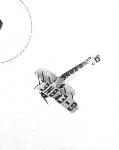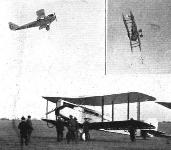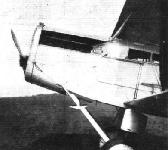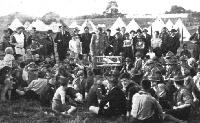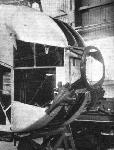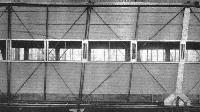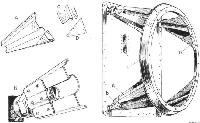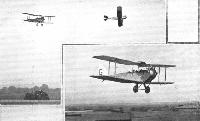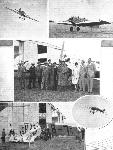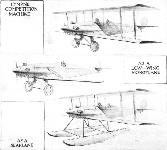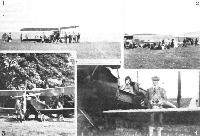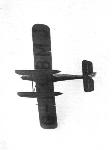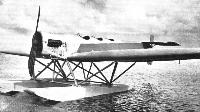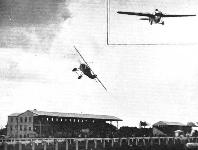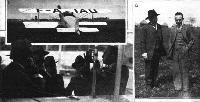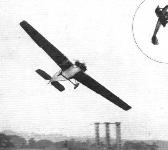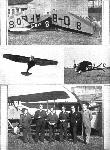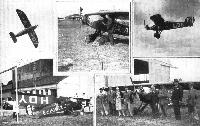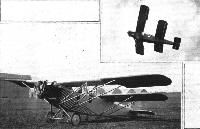Фотографии
-
Регистрационный номер: G-EBNE [2] THE BOURNEMOUTH AVIATION MEETING: General view of a corner of Ensbury Park Racecourse which was used as a machine park. Behind will be seen the portion reserved for motor cars.
Самолёты на фотографии: Avro Avro 504 - Великобритания - 1913
-
"JUNE FALLS IN AUGUST": On both Saturday and Sunday at the Bournemouth Aviation Meeting Miss June executed a graceful parachute (Calthrop) descent from an Avro piloted by Lieut.-Col. G. P. Henderson. She is seen on the left preparing to ascend, and, centre, just leaving the Avro, and finally, right, about to land.
Самолёты на фотографии: Avro Avro 504 - Великобритания - 1913
-
Регистрационный номер: G-EBNE [2] "SIDE AND UP-SIDE" LINES AT THE BOURNEMOUTH AVIATION MEETING: Bert Hinkler takes a good look at the ground from the Avro "Gosport" before landing after an exhibition flight.
Самолёты на фотографии: Avro Avro 504 - Великобритания - 1913
-
Регистрационный номер: L-BALG TWO DE HAVILLANDS: Capt. Broad flying Mrs. Eliott-Lynn's "Moth" above the Czechoslovak D.H.50 and, inset, doing one of his large-diameter slow loops.
Самолёты на фотографии: De Havilland D.H.50 - Великобритания - 1923De Havilland Moth / D.H.60 - Великобритания - 1925
-
An Anglo-Czech Alliance: The 230 h.p. Walter engine in the D.H.50
Самолёты на фотографии: De Havilland D.H.50 - Великобритания - 1923
-
VISITORS FROM CZECHOSLOVAKIA: During the Orly meeting a D.H.50 built in Prague under licence, arrived with distinguished passengers. This group, taken immediately after the arrival of the machine, includes, from left to right: Pavel Benes, Avia, chief designer; Dr. Lhota, amateur pilot and president of the Czechoslovak Pilots' Association; Mrs. Lhota; M. Srba, member of the Czechoslovak Diet; Maj. Krysner, director of Czechoslovak Railways; Capt. Josef Jira, Ing. Stocis, of the Ministry of Public Works; M. Brebenec, pilot of the D.H.50; and M. Milos Bondy, managing director of the Avia Co.
Самолёты на фотографии: De Havilland D.H.50 - Великобритания - 1923
-
"Teaching the Young Idea": An Air League Lecture at the camp of Welsh Scouts at Llandrindod Wells, August 4. The lecturer is seen explaining a model D.H. "Moth" to a batch of enthusiasts. About 1,000 Scouts were in camp, and a series of lectures with this model, supplemented by "FLIGHT" lantern slides, was given.
Самолёты на фотографии: De Havilland D.H.50 - Великобритания - 1923
-
THE ARMSTRONG-WHITWORTH "ARGOSY": The mounting of the central engine is somewhat unusual, being of the cantilever variety, which leaves ample space for getting at the back of the engine.
Самолёты на фотографии: Armstrong Whitworth Argosy - Великобритания - 1926
-
THE ARMSTRONG-WHITWORTH "ARGOSY": In the photograph in the upper left-hand corner is shown the top centre-section, lying upside down, with the attachments for the gravity petrol tanks, one of which is shown on the right (also upside down). Ball and socket joints are employed fairly extensively in the "Argosy" a typical one, from the centre of the undercarriage, being shown in the lower left-hand illustration. The substantial tail skid is shown on the right.
Самолёты на фотографии: Armstrong Whitworth Argosy - Великобритания - 1926
-
The Armstrong-Whitworth "Argosy": The steel tube fuselage has its main struts spaced fairly far apart, and the longerons are stiffened by auxiliary struts, as shown in this photograph of a portion of the cabin. The slope of some of the struts shown corresponds with the stagger of the wings.
Самолёты на фотографии: Armstrong Whitworth Argosy - Великобритания - 1926
-
THE ARMSTRONG-WHITWORTH "ARGOSY": Some constructional details. The sketch in the lower left-hand corner shows a typical pin-joint in the fuselage, while the right-hand sketch represents the fuselage joint at the point where the chassis strut and lower wing spar join the lower longerons of the fuselage. The top left-hand corner sketch is a section through the same point, showing how the beams supporting the floor boards of the cabin are secured by brackets to the vertical struts of the main fuselage structure.
Самолёты на фотографии: Armstrong Whitworth Argosy - Великобритания - 1926
-
THE ARMSTRONG-WHITWORTH "ARGOSY": The engine mounting in the nose of the fuselage is of the cantilever type, stiffness being provided by the corrugated corner brackets, of sheet steel. The absence of diagonal bracing greatly facilitates access to the back of the engine. The mounting with some of its details is shown.
Самолёты на фотографии: Armstrong Whitworth Argosy - Великобритания - 1926
-
Регистрационный номер: G-EBHZ THE BOURNEMOUTH AVIATION MEETING: The line up for the first event on Sunday - the Private Club Handicap, won by Capt. de Havilland's "Moth" (the third machine on the left).
Самолёты на фотографии: De Havilland Humming Bird / D.H.53 - Великобритания - 1923De Havilland Moth / D.H.60 - Великобритания - 1925
-
Регистрационный номер: G-EBDO [2], G-EBHS [4] A SPLENDID FINISH: The event of the day on Sunday at the Bournemouth Meeting was the final for the Bournemouth Summer Handicap. This was won - " at the last minute" - by D. A. N. Watt on the "Swallow" seen on the extreme left about to cross the line, from Flt.-Lieut. J. S. Chick on the R.A.E. "Hurricane," seen "jumping the hurdles" on the extreme right. Three remaining machines in the race are also to be seen (centre), the nearest being W. L. Hope on the "Moth" next A. S. Butler on the D.H.37, and, banking round into the straight, H. S. Broad on the red-and-white "Moth."
Самолёты на фотографии: De Havilland D.H.37 - Великобритания - 1922De Havilland Moth / D.H.60 - Великобритания - 1925RAE Hurricane - Великобритания - 1923Sopwith Scooter/Swallow - Великобритания - 1918
-
THE BOURNEMOUTH AVIATION MEETING: The Christchurch Sprint Scratch Race (Saturday). On the left, W. L. Hope wins the second heat of this event, and is thus able to (right) win the final, on his D.H. "Moth." Sparks, however, on the L.Ae.C. "Moth," is, it will be seen, a good second.
Самолёты на фотографии: De Havilland Moth / D.H.60 - Великобритания - 1925
-
THE FRENCH LIGHT 'PLANE COMPETITION AT ORLY: The eight competing machines: 1. No. 1, D.H."Moth," with its pilot, Mrs. Eliott-Lynn.
Самолёты на фотографии: De Havilland Moth / D.H.60 - Великобритания - 1925
-
Регистрационный номер: G-EBKT THE BRITISH TEAM: 1, from left to right: N. H. Jones, passenger; Mrs. Ellott-Lynn, pilot; R. Hyder and H. Webb, mechanics. 2, the D.H. "Moth" in a hurry. 3, just before the axle and wheel "went west." 4, Mr. Bramson lends a helping hand in the folding test. 5, visitors, including M. Laurent Eynac, interested in Mrs. Eliott-Lynn's easy starting of the "Cirrus" engine.
Самолёты на фотографии: De Havilland Moth / D.H.60 - Великобритания - 1925
-
THE BOURNEMOUTH AVIATION MEETING: Capt. H. S. Broad hurries off on the final of Sunday's Bournemouth Summer Handicap in the King's Cup D.H. "Moth."
Самолёты на фотографии: De Havilland Moth / D.H.60 - Великобритания - 1925
-
THE BOURNEMOUTH AVIATION MEETING: Three of the four D.H. "Moths" take off for the first event on Saturday - the Light Aeroplane Club Instructors' Scratch Race. The leading machine is one of the L.Ae.C. entries, then McDonough on the Midland Ae. C. 'bus, and finally Capt. G. I. Thomson (Hants Ae. C.) .
Самолёты на фотографии: De Havilland Moth / D.H.60 - Великобритания - 1925
-
Регистрационный номер: G-EBNO THE BOURNEMOUTH AVIATION MEETING: The Ensbury Park Low Power Handicap (Saturday). Top, Mrs. Eliott-Lynn (right) and S.L.F. St. Barbe flying their "Moths," in the first heat. Bottom, Capt. de Havilland on his Cirrus II "Moth," winning the final of this race.
Самолёты на фотографии: De Havilland Moth / D.H.60 - Великобритания - 1925
-
"SIDE AND UP-SIDE" LINES AT THE BOURNEMOUTH AVIATION MEETING: Capt. H. S. Broad makes a roll on the red-and-white King's Cup "Moth."
Самолёты на фотографии: De Havilland Moth / D.H.60 - Великобритания - 1925
-
THE WINNERS OF THE FRENCH LIGHT 'PLANE COMPETITION: In the centre the Czechoslovak Team, from left to right: Fous, works manager; Pacak, Volejnik and Horak, mechanics; Fritsch, chief pilot; Pavel Benes, chief designer; Capt. J. Jira, military pilot (not in the competition); Mrs. Lhota, Dr. Lhota and Milos Bondy, managing director. In the upper right-hand corner, Dr. Lhota is seen in the landing test, while the other two photographs show the Avias in different attitudes of flight.
Самолёты на фотографии: Avia BH-9 / BH-10 / BH-11 / BH-12 / BH-16 - Чехословакия - 1923
-
Регистрационный номер: L-BONI THE FRENCH LIGHT 'PLANE COMPETITION AT ORLY: The eight competing machines: 2. No. 4, Avia B.H.11 (pilot, M. Fritsch).
Самолёты на фотографии: Avia BH-9 / BH-10 / BH-11 / BH-12 / BH-16 - Чехословакия - 1923
-
THE FRENCH LIGHT 'PLANE COMPETITION AT ORLY: The eight competing machines: 3. No. 5, Avia B.H.11 (pilot, Dr. Lhota).
Самолёты на фотографии: Avia BH-9 / BH-10 / BH-11 / BH-12 / BH-16 - Чехословакия - 1923
-
THE AVRO "AVIAN": Fitted with one of the new Armstrong-Siddeley "Genet" engines, this machine will be produced in three forms as shown above. For the Lympne competition large wings are fitted. For speed rather than load-carrying, the upper wing is removed and the machine turned into a low-wing monoplane. Finally, it is proposed to fit it with floats for seaplane work.
Самолёты на фотографии: Avro Avian / Type 594/616 - Великобритания - 1926
-
THE AVRO "AVIAN": 1, Shows the tail skid with its small detachable roller, while the very light engine mounting is shown in detail in 2. The petrol and oil tanks are mounted on the top and side respectively of the fuselage as indicated in 3. The wing flap crank lever is illustrated in 4, and the differential aileron controls in 5 and 6.
Самолёты на фотографии: Avro Avian / Type 594/616 - Великобритания - 1926
-
THE AVRO "AVIAN": Some constructional details of the wings. 1, Shows the very simple rib construction and leading edge, while in 2 is shown a complete rib, the spar section, and the leading edge. The hinges for folding the wings are of simple type, as shown in 3, with ample bearing areas. The wing root on the fuselage, with steel plate fitting and hinge, is shown in 4.
Самолёты на фотографии: Avro Avian / Type 594/616 - Великобритания - 1926
-
Avro "Avian" Armstrong Siddeley "Genet" Engine
Самолёты на фотографии: Avro Avian / Type 594/616 - Великобритания - 1926
-
Регистрационный номер: G-EBGG [3] LONDON-CAIRO WITH A "JUPITER": The Bristol "Bloodhound" at Athens.
Самолёты на фотографии: Bristol Bloodhound / Type 84 - Великобритания - 1923
-
Регистрационный номер: G-EBGG [3] LONDON-CAIRO WITH A "JUPITER": Left, filling up with "Shell" at Sollum, an operation somewhat difficult of accomplishment, and, right, a first taste of Egyptian coffee.
Самолёты на фотографии: Bristol Bloodhound / Type 84 - Великобритания - 1923
-
Регистрационный номер: G-EBGG [3] London-Cairo with a "Jupiter": Willing helpers haul the "Bloodhound" out of the sand into which its wheels had sunk when alighting at Mersa Mathruh.
Самолёты на фотографии: Bristol Bloodhound / Type 84 - Великобритания - 1923
-
Регистрационный номер: G-EBDO [2] THE BOURNEMOUTH AVIATION MEETING: Two views of an enthusiastic owner-pilot: A. S. Butler, in his D.H.37 ("Nimbus"), starts off (left) on the Boscombe High Power Handicap, Saturday's record event, which he won, and (right), flying in the final of Sunday's Bournemouth Summer Handicap.
Самолёты на фотографии: De Havilland D.H.37 - Великобритания - 1922
-
AN AERIAL TOUR IN SCOTLAND: Col. the Master of Sempill carried out yet another aerial holiday from July 29 to August 7 last. This time !ie flew, with Mrs. Sempill, up in Scotland in Air Commodore J. G. Weir's D.H. 51 (Airdisco). We show above some snaps taken during this tour :- 1. The first aeroplane ever to land at John o'Groats; the D.H. 51 on the edge of the cliff. 2. A tenantry reception given in Col. Sempill's honour at Craigievar Castle. 3. The family butler of Fintray House, Aberdeenshire (Lord Sempill's estate), attended to the stocking of the D.H.51 's larder. 4. Princess Maud, who made her first aeroplane flight, and Lord Carnegie at Elsick House, Aberdeenshire. Col. Sempill covered during his tour approximately 1,600 miles in 18 flying hours.
Самолёты на фотографии: De Havilland D.H.51 - Великобритания - 1924
-
Регистрационный номер: G-EBMJ [2] THE SHORT "MUSSEL" TWO-SEATER SEAPLANE, 65 h.p. "Cirrus" Engine: These photographs show the machine at rest on the sea, taxying before taking off, in flight, and alighting. In the inset, an inquisitive gull has a look at its mechanical counterpart.
Самолёты на фотографии: Short Mussel / S.7 - Великобритания - 1926
-
Регистрационный номер: G-EBMJ [2] THE SHORT "MUSSEL": Mr. Lankester Parker puts the machine into a vertical bank.
Самолёты на фотографии: Short Mussel / S.7 - Великобритания - 1926
-
Один из первых самолетов в серии из семи построенных GL 18/GL 22. Один GL 18 использовался национальным авиаперевозчиком "Lufthansa" в 1926-1928 годах.
A NEW GERMAN COMMERCIAL MACHINE: The Focke-Wulf high-wing monoplane with two air-cooled Junkers engines of 70 h.p. each, has accommodation for pilot and three passengers, and is to be put into regular use on some of the German "feeder lines." The pilot's cockpit is in the nose, where the view forward and downwards is very good. The windscreen slopes up to the leading edge of the wing.Самолёты на фотографии: Focke-Wulf GL.18 / GL.22 - Германия - 1926
-
BRITISH SUCCESS IN GERMANY: First Prize in the seaplane competition, which has just been concluded at Warnemunde, was won by the Heinkel H.E.5 monoplane with Napier "Lion" engine shown in above photograph.
Самолёты на фотографии: Heinkel HE.1 - HE.5, HE.8 - HE.9 - Германия - 1923
-
CRUISE OF THE "SOUTHAMPTONS": The two Supermarine flying-boats, Napier "Lion" engines, arriving at the Cattewater seaplane station, after their successful flight of nearly 7,000 miles.
Самолёты на фотографии: Supermarine Southampton / Solent - Великобритания - 1925
-
THE BOURNEMOUTH AVIATION MEETING: Two items from Sunday's big race - the Bournemouth Summer Handicap. D. A. N. Watt (who eventually won the race) winning the second heat on the "Swallow," and, inset, Flt.-Lieut. J. S. Chick winning the third heat.
Самолёты на фотографии: Sopwith Scooter/Swallow - Великобритания - 1918
-
Регистрационный номер: F-AIAQ THE BRAMSON ANTI-STALL GEAR IN FRANCE: 1. Mr. L. Bramson takes off at Orly on the "Amiot" (S.E.C.M.) biplane to demonstrate the Bramson anti-stall gear. 2. Mr. Bramson explains matters to M. Laurent Eynac (ex Under-Secretary for Air) and M. Fortant. 3. Mr. Bramson (right) with M. Odier (left), who is going to manufacture this anti-stall gear in France, under licence.
Самолёты на фотографии: SECM (Amiot) SECM 22 / 23 - Франция - 1922
-
Регистрационный номер: G-EBHS [4] "SIDE AND UP-SIDE" LINES AT THE BOURNEMOUTH AVIATION MEETING: Flt.-Lieut. J. S. Chick making a test flight on the R.A.E. "Hurricane" (Bristol "Cherub").
Самолёты на фотографии: RAE Hurricane - Великобритания - 1923
-
Регистрационный номер: G-EBHS [4] The calm arrival of the "Hurricane" at Bournemouth: The R.A.E. "Hurricane" (Bristol "Cherub") came to Bournemouth by road, as shown.
Самолёты на фотографии: RAE Hurricane - Великобритания - 1923
-
Регистрационный номер: G-EBHS [4] THE BOURNEMOUTH AVIATION MEETING: Item from Sunday's big race - Flt.-Lieut. J. S. Chick winning the third heat.
Самолёты на фотографии: RAE Hurricane - Великобритания - 1923
-
Регистрационный номер: O-BAFL [2] THE BELGIAN TEAM: In the lower photograph, from left to right: de Bruycker, mechanic; Wouters, pilot; Jullien, designer; Van Opstal, pilot; Guldentops, constructor; and Poncelet, constructor. The puzzle picture at the top shows the Poncelet monoplane doing the folding test, while the remaining photographs show the same machine flying and doing the landing test. In the latter the door is held open to act as an air brake.
Самолёты на фотографии: SABCA DP (Demonty-Poncelet) - Бельгия - 1924
-
Регистрационный номер: O-BAFL [2] THE FRENCH LIGHT 'PLANE COMPETITION AT ORLY: The eight competing machines: 6. No. 8, Demonty-Poncelet D.P.I (pilot, Wouters).
Самолёты на фотографии: SABCA DP (Demonty-Poncelet) - Бельгия - 1924
-
Регистрационный номер: F-AIDZ [2] No. 16: The French-built Pander monoplane entered and flown by MM. Roques and Lefolcalvez, who are seen standing by the machine. Above: left, making a good landing in the tests, and, right, in flight. A poor engine prevented this machine from doing itself justice.
Самолёты на фотографии: Holland (VIH) H.2 - Нидерланды - 1924
-
Регистрационный номер: F-AIDZ [2] THE FRENCH LIGHT 'PLANE COMPETITION AT ORLY: The eight competing machines: 8. No. 16, Roques-Lefolcalvez (pilot, Roques or Lefolcalvez).
Самолёты на фотографии: Holland (VIH) H.2 - Нидерланды - 1924
-
Регистрационный номер: F-AHDY [2], F-AIDB [2] THE ALBERT-SALMSON TEAM: In the lower right-hand corner, from left to right: Delzongles, chief mechanic; Descamps, pilot of No. 7; Madame Descamps; Duhamel, designer; Albert, constructor; Thoret, pilot; Magnet (of the Salmson Company), and Metrot, also of the Salmson Company. On the left, Thoret's monoplane passing the folding test. Above, M. Albert trying vainly to start the engine with a "Heath Robinson" starter, and in the upper corners the two machines in flight.
Самолёты на фотографии: Albert TE.1 / R.100 - Франция - 1926
-
Регистрационный номер: F-AHDY [2] THE FRENCH LIGHT 'PLANE COMPETITION AT ORLY: The eight competing machines: 4. No. 6, Albert T.E.1 (pilot, Descamps).
Самолёты на фотографии: Albert TE.1 / R.100 - Франция - 1926
-
Регистрационный номер: F-AIDB [2] THE FRENCH LIGHT 'PLANE COMPETITION AT ORLY: The eight competing machines: 5. No. 7, Albert T.E.1 (pilot, Thoret).
Самолёты на фотографии: Albert TE.1 / R.100 - Франция - 1926
-
THE FRENCH LIGHT 'PLANE COMPETITION AT ORLY: The eight competing machines: 7. No.9, Demonty-Poncelet, "Camgul II" (pilot, Van Opstal)
Самолёты на фотографии: Cambier CG.2 Camgul - Бельгия - 1925
-
No. 13: The Albessard tandem monoplane with 70-h.p. Anzani engine was entered for the competition, but did not arrive until about the middle of the week and did not attempt any of the tests. It is a tandem monoplane constructed by M. Louis Peyret.
Самолёты на фотографии: Albessard Triavion - Франция - 1926
-
Nippon's Royal Prince Flies: As reported in FLIGHT recently, His Imperial Highness Prince Chichibu, the second son of the Emperor of Japan, experienced the pleasures of flying for the first time at the Stag Lane Aerodrome. Our photograph shows the Prince with Col. the Master of Sempill - his pilot - standing beside a D.H. biplane fitted with a Siddeley "Jaguar" engine, on which one of his flights was made.
Самолёты на фотографии: De Havilland D.H.9J - Великобритания - 1926
Статьи
- Flight

